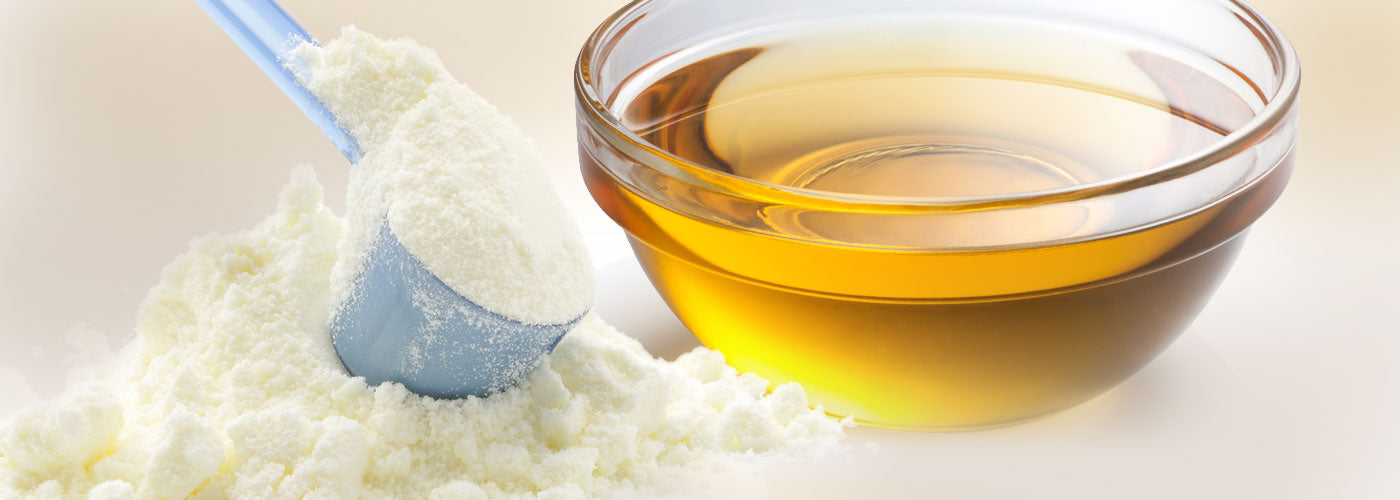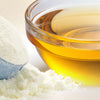MCT Powder vs. MCT Oil: Which One’s Better for You?


MCTs… you’ve probably heard about them as an all-natural way to boost energy and lose weight. Maybe you’re interested in trying them but don’t know where to start. Maybe you want to better understand what they are and how they work to provide health benefits. In this article, we’ll cover what MCTs are, the health benefits they offer, and explain the difference between the oil and powder forms of MCT.
First, let’s start off with a brief tutorial of what MCTs are and why you want them in your body. MCT stands for medium-chain triglyceride. The body forms triglycerides by joining three fatty acids to a glycerol backbone, making fatty acids water soluble for transport in the blood and use in the body. Most unsaturated fats (including omega-3s and omega-6s) are shorter-chain fatty acids, consisting of 8 to 14 carbons, while most saturated fats (including coconut oil) are long-chain fatty acids, having 16 to 20 carbon bonds. MCT oil is a synthetic fat (more on that in a bit) consisting of 8 to 14 carbons. Due to their unique length and makeup, they are quickly and easily digested, easily converted into ketones in the liver for use as energy, and not stored as fat in adipose tissue (a.k.a. body fat).
MCT Oil
MCT oil has been used therapeutically for many years to assist with a variety of nutritional and neurological conditions such as Crohn’s disease, fat malabsorption syndrome, epilepsy, and failure to thrive in newborns [1]. In fact, just over 10% of the fat content in breast milk comes from MCTs and synthetic MCT oil is added to most commercial infant formulas for its health benefits and to help with brain development. Other benefits of the therapeutic use of MCT oil include improved gut health from their naturally occurring antimicrobials [2, 3], increased brain function due to rapid ketone production, and increased metabolic function due to their thermogenic effect (increased calorie burn) [3].
While MCTs do occur naturally in small amounts in some foods, such as milk fat, coconut oil, and palm oil, commercial MCT oil is a synthetic product combining optimal ratios of these naturally occurring MCTs. The four MCTs found naturally occurring in foods are Caproic Acid (the shortest in length with 6 carbons), Caprylic Acid (8 carbons), Capric Acid (10 carbons), and Lauric Acid (12 carbons) [1]. The shorter the MCT, the faster it is converted to ketones in the liver, providing fast energy for the brain and body. Therefore, when shopping for products, it is best to look for oils with higher ratios of shorter MCTs (typically caprylic and capric acids) for efficiency in energy production.
MCT oil is great drizzled on salads and vegetables, added to soups and broths, mixed into full-fat yogurt and cottage cheese, or blended into coffee and tea. It can also replace olive oil in salad dressings and sauces (such as pesto and chimichurri). Avoid using MCT oil for cooking because it has a low smoke point; coconut oil is a better option due to a higher smoke point.
MCT Powder
MCT powder is a more recent version of the good stuff that has some benefits over its oil counterpart. Most MCT powders have somewhere between a 50%-80% MCT oil makeup, with the remainder of ingredients coming in the form of starch derivatives (carbs) and milk proteins. It is important to seek out products that contain a high Fat:Protein+Carb ratio in order to prevent insulin spikes and subsequent decrease in ketone production. An example of a good ratio is 70:30.
MCT Powder vs. MCT Oil
Why choose a powder vs. an oil? For most people, the number one reason is convenience. Powders are often sold in single-serve packets for easy transportation and on-the-go consumption. They’ll even make it through airport security! They can be added to liquids to make a shake or added to coffee as a “creamer.” They can be combined with exogenous ketone supplements to create a ketone-boosting powerhouse.
The other main reason many people opt for powders over oils is because they are more tolerable in the gut. Most people note fewer symptoms of gastrointestinal distress when using powders over oil. With less tummy distress, a greater amount of MCT powder can be consumed, leading to increased ketone production. It’s recommended to introduce MCTs in small amounts and to consume it slowly (over half an hour). If you’re new to MCT oil, start with a teaspoon and work your way up to a full tablespoon. With the powder form, start with half a serving size and work your way up to a full serving over a few days.
Conclusion
Whichever form you choose, MCTs are a great way to take your ketogenic lifestyle to the next level. They’re an all-natural way to manage weight, improve your physical and mental performance, and help curb cravings.
References:
- Mahan, L.K.; Escott-Stump, S., Raymon, J.L. Krause’s Food and the Nutrition Care Process, 13th 2012, 46, 632.
- Mercola, Joseph. Fat for Fuel: A Revolutionary Diet to Combat Caner, Boost Brain Power, and Increase Your Energy. 2107, 84-86.
- Rial, S.A.; Karelis, A.D.; Bergeron, K-F.; Mounier, C. Gut Microbiota and Metabolic Health: The Potential Beneficial Effects of a Medium Chain Triglyceride Diet in Obese Individuals. https://www.ncbi.nlm.nih.gov/pmc/articles/PMC4882694/




